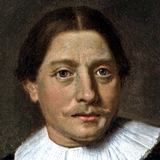 |
| Abel Tasman |
Abel Janszoon Tasman (1603?-1659), mariner, was born at Lutjegast, near Groningen, in the Netherlands. He received a sufficient education to enable him to express his ideas clearly in writing and to become a skilled navigator. He married Claesgie Meyndrix, by whom he had a daughter. After his wife died, he married Joanna Tiercx in January 1632. Soon afterwards, as a sailor before the mast, he sailed for the East Indies, where he was a first mate in February and a skipper in May 1634. In that year in a minor exploration he had a narrow escape from death, when in an incautious landing several of his companions were massacred by people of Ceram. After spending some time in warlike and anti-smuggling operations he returned to Holland in 1637.
He sailed for the Indies again in 1638 as skipper of a flute, taking his wife with him. From the outset he was treated as one of the most reliable skippers there. He was at first employed in military and trading voyages, but in 1639 was appointed second-in-command, under Quast, of two ships which set out in June to find islands believed to lie east of Japan. He returned in November from this search. Despite a disastrous death-toll on it, he offered to repeat the search, but was sent instead on trading voyages to Japan and Cambodia.
In 1642 he was appointed to command two ships to explore southern and eastern waters. Sailing in August he discovered Van Diemen's Land, New Zealand, the Tonga Islands and some of the Fiji group, and re-explored part of the north coast of New Guinea. On his return to Batavia in June 1643 he was chosen to take part in an expedition to form a settlement in the Tonga Islands from which the Chilean coast was to be raided; while this expedition was preparing, he was ordered to find whether there was a passage into the South Sea between Carpentaria and De Witt's Land. For this purpose he set out with three vessels at the end of January 1644 and, following the coasts from Cape Valsche round to Cape Cloates, satisfied himself that, except perhaps at Endeavour Strait, there was no passage. He was rewarded after his return in August 1644 by confirmation in the grade of commandeur, with a substantial increase in pay dated back to the beginning of his voyage in 1642.
The plan to raid Chile was abandoned, and Tasman was appointed to the Council of Justice at Batavia. In mid-1647 he was sent on a mission to the King of Siam and was granted precedence over all Dutchmen in the kingdom. After that mission, he was given command of a fleet of eight vessels which sailed in May 1648 against the Spaniards. His conduct in this operation was unsatisfactory and, after his return in January 1649, proceedings were taken against him for having, when inflamed by liquor, treated one of his sailors in a barbarous way; as a result he was removed from office during the governor-general's pleasure. He was formally reinstated in January 1651, but not long afterwards retired from the service and became a merchant in Batavia. He died there in affluent circumstances in 1659. His daughter by his first marriage had married first Philip Heylman, and later Jacob Bremer. In 1661 permission was given for his widow to marry Jan Meyndert Springer.
Tasman was a member of the Reformed Church. He was a brave and energetic mariner, a humane and properly cautious explorer, and a conspicuously able commander, though over-hasty on one occasion at least. Reflections which have been cast upon his courage are the fruit of ignorance. There are two supposed portraits of him: one owned by the Royal Commonwealth Society in London, the other in the National Library in Canberra.
Source: http://adb.anu.edu.au/biography/tasman-abel-janszoon-2716
The Dutch have endowed humanity with many great treasures: Hugo Grotius' treatise on international waters encouraging peaceful movement of people, Mercators maps allowed the world to be navigated more easily; Huygens added to the knowledge of the stars; and so on. Abel Tasman is another of those such men. He added to humanities knowledge of the physical world by exploring and mapping out parts of Australia, New Zealand and many islands in the South Pacific, which have allowed Europeans to explore, inhabit, and utilise them to their own and humanities betterment.
And he did all of that without the use of sat-nav or Google Earth!
[End.]
No comments:
Post a Comment